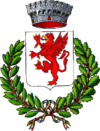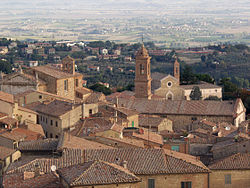- Montepulciano
-
This article is about the town in Tuscany, Italy. For other uses, see Montepulciano (disambiguation).
Montepulciano — Comune — Comune di Montepulciano Panorama of Montepulciano 
Coat of armsLocation of Montepulciano in Italy Coordinates: 43°06′N 11°47′E / 43.1°N 11.783°E Country Italy Region Tuscany Province Siena (SI) Frazioni Abbadia, Acquaviva, Argiano, Ascianello, Cervognano, Fonte al Giunco, Gracciano, Montepulciano Stazione, Nottola, Salcheto, Sant'Albino, Tre Berte, Valiano Government – Mayor Andrea Rossi (Democratic Party) Area – Total 165.58 km2 (63.9 sq mi) Elevation 605 m (1,985 ft) Population (30 April 2009) – Total 14,476 – Density 87.4/km2 (226.4/sq mi) Demonym Poliziani or Montepulcianesi Time zone CET (UTC+1) – Summer (DST) CEST (UTC+2) Postal code 53045 Dialing code 0578 Patron saint St. John the Baptist Saint day August 29 Website Official website Montepulciano is a medieval and Renaissance hill town and comune in the province of Siena in southern Tuscany, in Italy. Montepulciano, with an elevation of 605 m, sits on a high limestone ridge. By car it is 13 km E of Pienza; 70 km SE of Siena, 124 km SE of Florence, and 186 km north of Rome.
Montepulciano is a major producer of food and drink. Montepulciano is known world-wide for its wine. Wine connoisseurs consider its Vino Nobile among Italy's best. However, the Vino Nobile di Montepulciano should not be confused with the varietal wine (Montepulciano grape) of the same name. Montepulciano is also known for its pork, cheese, "pici" pasta (a thick, rough, chewy variant on spaghetti), lentils, and honey.
Contents
History
The name of Montepulciano derives from Latin Mons and Publicianus ("Mount of Publicianus"). According to legend, it was founded by the Etruscan King Porsenna of Chiusi; recent findings prove that a settlement was already in existence in the 4th-3rd centuries BC. In Roman times it was the seat of a garrison guarding the main roads of the area.
After the fall of the Western Roman Empire, it developed as a religious center under the Lombards. In the 12th century it was repeatedly attacked by the Republic of Siena, which the Poliziani faced with the help of the Perugia and Orvieto, and sometimes Florence, communes. The 14th century was characterized by constant struggles between the local noble families, until the Del Pecora family became rulers of the town. From 1390, Montepulciano was a loyal ally (and later possession) of Florence and, until the mid-16th century, lived a period of splendour with architects such as Antonio da Sangallo the Elder, Jacopo Barozzi da Vignola, Baldassarre Peruzzi, Ippolito Scalza and others, building luxurious residences and other edifices here. In 1559, when Siena was conquered by Florence and Montepulciano lost its strategic role, its importance declined.
After the unification of Italy and the drying of the Val di Chiana, the town remained the most important agricultural centre in the area, while the industrial activities moved mostly next to Chiusi, which was nearer to the railroad being built in that period.
Main sights
The main street of Montepulciano stretches for 1.5 kilometers from the Porta al Prato to the Piazza Grande at the top of the hill. The city is renowned for its walkable, car-free nature. The main landmarks include:
- The Palazzo Comunale, designed by Michelozzo in the tradition of the Palazzo della Signoria (Palazzo Vecchio) of Florence.
- Palazzo Tarugi, attributed to Antonio da Sangallo the Elder or Jacopo Barozzi da Vignola. It is entirely in travertine, with a portico which was once open to the public.
- The Cathedral of Santa Maria Assunta, or the Duomo of Montepulciano, constructed between 1594 and 1680, includes a masterpiece from the Sienese School, a massive Assumption of the Virgin triptych painted by Taddeo di Bartolo in 1401.
- The church of Santa Maria delle Grazie (late 16th century). It has a simple Mannerist façade with a three-arcade portico. The interior has a single nave, and houses a precious terracotta altar by Andrea della Robbia.
- The Sanctuary of the Madonna di San Biagio is on the road to Chianciano outside the city. It is a typical 16th century Tuscan edifice, designed by Antonio da Sangallo the Elder on a pre-existing Pieve, between 1518 and 1545. It has a circular (central) plan with a large dome over a terrace and a squared tambour. The exterior, with two bell towers, is built in white travertine.
The walls of the city date to around the 14th century.
Gallery
Famous citizens
- Roberto Bellarmino, a Roman Catholic Saint, Cardinal, and Doctor of the Church was born here on October 4, 1542. He is one of the 33 Doctors of the Roman Catholic Church and was active in the Counter-Reformation.
- Agnes of Montepulciano, a Roman Catholic Saint.
- The Florentine classical scholar and poet, as well as one of the revivers of Humanist Latin, Angelo Poliziano was born in Montepulciano on July 14, 1454.
- The members of the music band "Baustelle", formed in 1994, have origins in the town.
International relations
See also: List of twin towns and sister cities in ItalyTwin towns — Sister cities
Montepulciano is twinned with:
Montepulciano in fiction
Linda Proud's The Botticelli Trilogy centres on the life of Angelo Poliziano. The second volume in particular, Pallas and the Centaur (2004), deals with his boyhood in Montepulciano, and the life of his sister Maria. The novel contains vivid detail of the city and surrounding country and an authoritative account of the murder of Poliziano's father derived from local knowledge. Twilight Saga: New Moon was filmed in Montepulciano as a stand in for the Italian City of Volterra, the city where the Volturi live.
External links
 Media related to Montepulciano at Wikimedia Commons
Media related to Montepulciano at Wikimedia Commons- Comune di Montepulciano official site (Italian)
Tuscany · Comuni of the Province of Siena Abbadia San Salvatore · Asciano · Buonconvento · Casole d'Elsa · Castellina in Chianti · Castelnuovo Berardenga · Castiglione d'Orcia · Cetona · Chianciano Terme · Chiusdino · Chiusi · Colle di Val d'Elsa · Gaiole in Chianti · Montalcino · Montepulciano · Monteriggioni · Monteroni d'Arbia · Monticiano · Murlo · Piancastagnaio · Pienza · Poggibonsi · Radda in Chianti · Radicofani · Radicondoli · Rapolano Terme · San Casciano dei Bagni · San Gimignano · San Giovanni d'Asso · San Quirico d'Orcia · Sarteano · Siena · Sinalunga · Sovicille · Torrita di Siena · TrequandaCategories:- Cities and towns in Tuscany
- Communes of the Province of Siena
- Hilltowns in Italy
- Hilltowns in Tuscany
Wikimedia Foundation. 2010.







